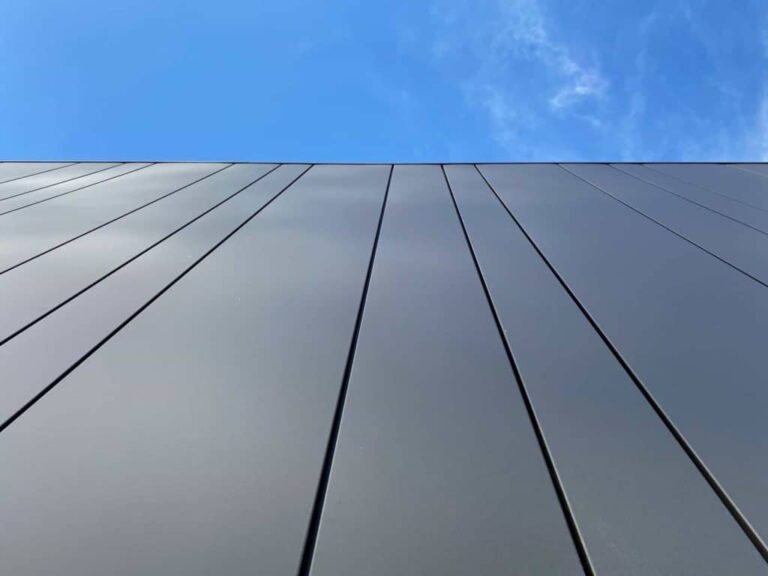The application of metal material on exterior building surfaces represents metal cladding. The weather protection of the cladding serves alongside its decorative function to improve the building’s outward appearance. This article will fully explain the modern building material by examining various forms of metal cladding alongside its benefits, implementation practices and architectural applications.
What is Metal Cladding?
Metal cladding represents a construction method that calls for using metal sheets or panels as exterior structural finishes. Metal products such as copper, steel, zinc and aluminium find use in making these panels because they combine strength with excellent durability and weather resistance. The building frame receives metal panels through attachments that use rails and clips, and fasteners for their connection.
Moving forward, metal cladding fulfils protective functions and adds both enhanced thermal performance and a more appealing design appearance, together with superior sound reduction capabilities. Metal cladding shows versatility in different architectural choices, so it becomes a common choice for residential and commercial structures.
Types of Metal Cladding
Metal cladding material exists in multiple forms that offer exceptional traits to each type. Building intended uses together with budget limits and design expectations, determine what type of metal cladding will be selected.
1. Cladding made of aluminium
People choose aluminium for cladding applications because of its outstanding thermal insulation properties combined with lightweight and corrosion-resistant qualities. The material works well in contemporary buildings because processing different textures and colours becomes possible for this material. Commercial properties, including office complexes, together with shopping malls, regularly implement aluminium cladding solutions.
2. Cladding made of steel
Steel possesses durability and longevity because it exceeds aluminium in weight. Industrial and warehouse structures, as well as factories, often select metal cladding because these buildings require robustness along with high resilience. Stainless steel serves as a corrosion-resistant steel type for cladding operations since it displays smooth, modern aesthetics.
3. Cladding in copper
The natural process of copper development results in its transformation into a warm reddish-brown patina. Building elegance together with sophistication comes from employing this material in elite high-end architectural works. Copper maintains such strong durability and corrosion resistance that builders continuously select it to protect outdoor cladding against harsh conditions.
4. Cladding made of zinc
For a durable solution that needs minimal upkeep, zinc cladding allows the accumulation of a distinctive patina that provides an aged appearance. Under harsh environmental situations, zinc demonstrates high resistance to degradation. Zinc cladding finds its application in modern industrial settings for residential and commercial properties.
5. Cladding made of corten steel
Corten steel maintains a stable rust-like finish after exposure to the outside elements, also known as weathering steel. The natural rust formation on corten steel serves dual purposes by creating the attractive look and safeguarding the metal from additional corrosion processes. The architectural adoption of corten steel happens when designers wish to achieve industrial or rustic appearances.
6. Cladding made of titanium
The high-end material titanium stands out because it delivers exceptional strength while being durable and lightweight in nature. The relatively high cost of titanium cladding matches its modern appearance, which functions exceptionally well against harsh conditions. Luxury residential buildings, along with luxury developments, frequently select this metal.
Metal Cladding Application
1. Commercial Structures
Metal cladding finds regular application as an exterior covering on both commercial business structures and industrial facilities like office skyscrapers and shopping malls, in addition to factories and warehouses. This material works perfectly in high-traffic areas and places with large public exposure because it lasts long with minimal care needs.
2. Household Structures
Metal cladding remains a desired choice for contemporary homes because it continues to gain popularity in residential buildings. The material presents an elegant modern look which harmonises successfully with concrete and glass among other construction elements. Metal cladding serves residential buildings with numerous units because it demands minimal care and exhibits efficient energy usage.
3. Walls and Facades Outside
Buildings use metal cladding for their exterior walls along with facades, as this solution enhances design quality and protects them from environmental elements. Building owners have a wide selection of design options since metal cladding allows placement in specific design patterns while providing options between vertical and horizontal installation.
4.Systems for Roofs
Metal cladding serves two uses by covering roof systems and external walls. Building structures that operate commercially and industrially prefer metal roofs because of their excellent weather endurance, along with durability.
5. Architectural Elements
Metal cladding functions for wall and roof protection, but specific applications also entail using it for creating decorative screens and soffits alongside column coverings. Structural designers alter metal cladding for precise implementation in various building design requirements.
Installing Metal Cladding
Design and Preparation: The building’s structure must be examined to make sure it can support the cladding before installation. After that, the metal cladding system’s design and specs are completed, taking into consideration the building’s climate, aesthetic preferences, and energy efficiency needs.
Repairing the Panels: Rails, clips, or fasteners are used to secure the metal panels to the building’s framework. Usually, the panels are arranged in rows, working their way up from the bottom. The metal can expand and contract due to heat, thanks to the spaces between the panels.
Final Details: After the panels are fastened, the cladding system is finished with trim, joints, and sealants to make sure the building is both aesthetically beautiful and weatherproof.
Conclusion
Through its innovative properties, metal cladding enables buildings to obtain durability alongside low maintenance needs and multiple looks. Various metal types with specific benefits enable the use of metal cladding for both residential and commercial buildings. The installation of metal claddings provides a durable and elegant protection system which maintains energy efficiency and enhances architectural design.
Enjoyed this? Share this post with fellow fans and influencers, and be sure to check back regularly for the latest updates, insights, and news on all things simpcity!

